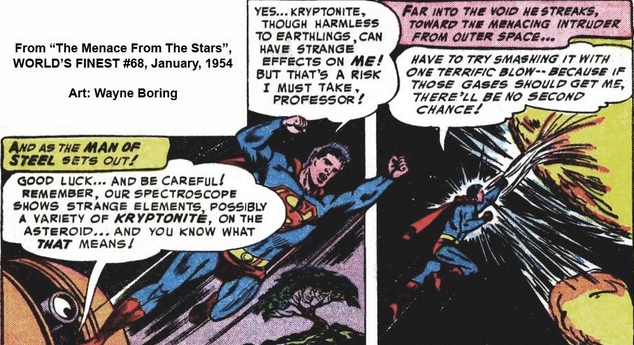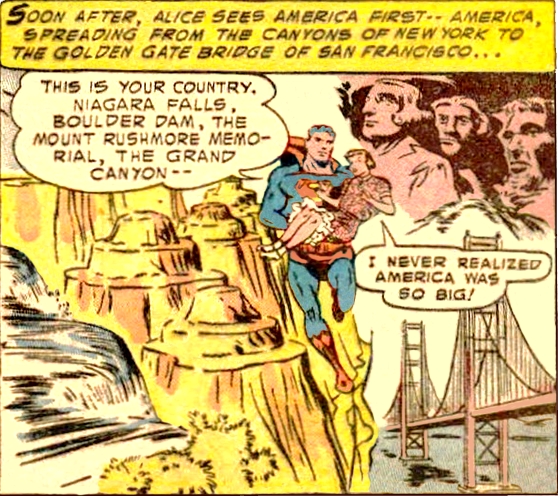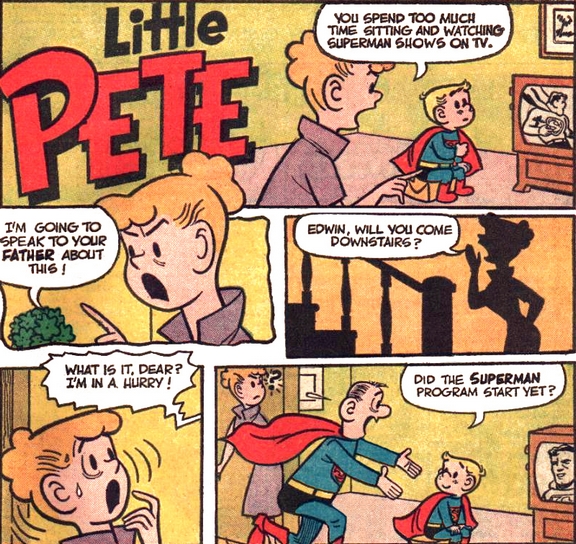Front Cover
TAC Table of Contents
Contact Information
|
by Kirk Hastings (All illustrations ©DC Comics)  A comic book prediction that five years later would come true! From ACTION COMICS #126 - November, 1948 Art by Al Plastino  Full page ad from SUPERMAN #75 - March 1952, advertising the release of Superman and the Mole Men in movie theaters. Art by Wayne Boring  An award received by National Comics for its 1953 production of Stamp Day For Superman. From SUPERMAN #99 - August, 1954 It is pretty well known that Whitney Ellsworth and Mort Weisinger both worked on the Adventures of Superman TV show, as producer and story editor, respectively. It's also well known that they were both editors for the Superman line of comic books, published by DC Comics (then known as National Comics). This being the case, it was almost inevitable that some comic book stories would end up being adapted for the television show, and that some television episodes would be adapted into comic book format. In fact, both are true. One example (which may or may not be a coincidence): in a story published in Superman #77 (July, 1952) entitled "The Greatest Pitcher In The World", one of the crooks is known as "The Fixer". Now this character, who illegally "fixed" ball games, may or may not have been the inspiration for "The Fixer" (played by Leonard Penn) in the 1953 TV episode "The Boy Who Hated Superman". On the surface there appears to be little resemblance between the two characters. However, there is a much more blatant resemblance between the classic 1953 television episode "Panic In The Sky" and a story published in World's Finest Comics #68 in January of 1954 entitled "The Menace From The Stars". In both stories, Superman collides with an asteroid threatening the Earth which contains Kryptonite, and he loses his memory as a result. The two stories part ways at that point, though, as to how Superman handles this problem. He turns to his friends for help in the TV show; in the comic book he muddles around doing super-deeds (he thinks his super-powers come from the strange costume he is wearing) until he finally figures out by accident who he really is. Since the comic book story comes AFTER the TV episode in this case, we can assume that the TV episode written by Jackson Gillis came first, and then the comic book story was adapted from it.  The next example of the comic book and the TV series crossing paths occurs in Superman #88 (March, 1954). In a story written by Jerry Coleman and drawn by Al Plastino, we are introduced to "The Dog Who Loved Superman". The story is obviously based on the 1953 TV episode "The Dog Who Knew Superman", written by David Chantler. But again there are significant differences between the two. In the comic book the dog's name is Reginald; in the TV episode it is Corky. The plot of both adventures follow each other fairy closely -- except for the fact that the TV episode has a much more heart-tugging ending. When Clark Kent has to say goodbye to Corky at the end of the TV show, we are convinced that George Reeves (who had his own pet dog named Sam) really believed that a dog is "man's best friend".  From SUPERMAN #88 - March, 1954 Art by Al Plastino In issue #91 of Superman (Aug., 1954) there is a cover story entitled "Great Caesar's Ghost" by writer Bill Woolfolk and artist Al Plastino, about Perry White actually calling up the specter of the ancient Roman general through the constant use of his favorite epithet. This appears at about the same time as the 1954 Superman TV episode with the same title, written by Jackson Gillis. Both stories parallel each other fairly closely.  SUPERMAN #91 - August, 1954 Art by Al Plastino In issue #93 of Superman (Nov., 1954) there is a story entitled "Jimmy Olsen's Double", written by Bill Finger and drawn by Wayne Boring. Other than the plot device of Jimmy being replaced by a criminal who looks just like him, there is little resemblance between this comic book story and the 1955 TV episode "Jimmy The Kid", written by Leroy H. Zehren.
In January of 1955 Action Comics #200 presented the story "Test of a Warrior", wherein Superman attempts to help the father of a young Native American boy pass a rigged test in order to maintain the leadership of his tribe. No doubt this story was adapted from the 1954 TV episode of the same name (written by Leroy H. Zehren), as the plots of the two adventures resemble each other quite closely.  ACTION COMICS #200 - January, 1955 Art by Win Mortimer They were apparently short some story ideas for Jimmy Olsen #3 (Jan., 1955), because not one but two stories in that issue were adapted pretty directly from the TV series! The first story in that issue, "The Boy Millionaire" (written by Otto Binder and drawn by Curt Swan) is an almost identical clone of the 1954 TV episode "Olsen's Millions" (written by David Chantler). The second story in that same issue, "The Fastest Gun In The West," also written by Binder, is an almost exact copy of "The Bully of Dry Gulch" TV episode (also written by Chantler)!   Both samples from JIMMY OLSEN #3 - January, 1955 Art by Curt Swan The next comic book story adapted from a TV episode was "The Challenge of Stoneman" in Action Comics #201 (Feb., 1955). This story was adapted from "Through The Time Barrier", the very first color episode of the Adventures of Superman in 1954. Whoever wrote the comic book story has been lost to history; however, we know that artist Al Plastino drew it. The TV episode was written by David Chantler. Both follow each other pretty closely, though in the comic book story Superman doesn't have the same problem getting through the time barrier that he does in the TV episode.  ACTION COMICS #201 - February, 1955 Art by Al Plastino
Jimmy Olsen #4 (March, 1955) features still another adaptation of a 1954 TV episode. The comic book story is "King For A Day", and it was adapted from the TV episode of the same name. The comic book story was written by Otto Binder and drawn by Curt Swan; the TV episode was written by Dwight Babcock. Both stories are pretty similar in content.  From JIMMY OLSEN #4 - March, 1955 Art by Curt Swan In Superman #96 (March, 1955), we encounter "The Girl Who Didn't Believe In Superman", a story written by Bill Finger (and drawn by Wayne Boring) that was adapted from the final TV episode of 1953, "Around The World With Superman", written by Jackson Gillis. The plots of both stories are similar, although the storylines differ from each other somewhat. In the comic book story, the girl in question is named Alice Norton; in the popular TV episode she is Ann Carson (played by Judy Ann Nugent).  From SUPERMAN #96 - March, 1955 Art by Wayne Boring Two issues later, in Superman #98 (July, 1955), is the story "Clark Kent, Outlaw", written by Bill Finger and drawn by Wayne Boring. This story is closely adapted from the 1954 TV episode of the same name, written by Leroy H. Zehren.  From SUPERMAN #98 - July, 1955 Art by Wayne Boring Finally, we find the story "Superman Marries Lois Lane" in Action Comics #206 (July, 1955), drawn by Wayne Boring. We don't know who wrote the comic book script for this tale, but we do know that Jackson Gillis wrote the extremely similar "Wedding of Superman" TV episode during that same year, 1955. Both episodes end up being a dream had by Lois Lane, and the referred-to "wedding" never actually takes place.  On the next page of the comic book, Lois would awaken to the sound of her alarm clock going off, and realize that everything was a dream. From ACTION COMICS #206 - July, 1955 Art by Wayne Boring  Comic book ad featured in many 1950s DC comic magazines; this one is from 1954  A cartoon salute to the TV series! From JIMMY OLSEN #70 - July, 1963 Art by Henry Boltinoff |